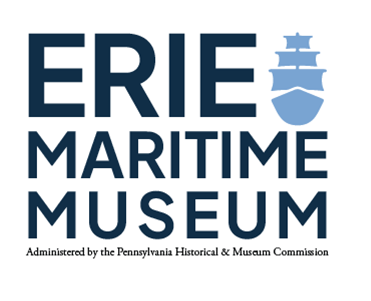American Cultural Music of the 19th Century
Music has been a key way to communicate, share stories, and express emotions for centuries. It helps build communities and unite people. In times of conflict, armies have used music and instruments to boost morale, keep troops in rythym, and relay commands. Drums and fifes were common instruments employed within military structures as drums were loud and clear, while fifes were shrill, making them easy to hear over the noise of battle.
CYRUS TIFFANY’S FIFE
This fife - found in the Erie Maritime’s extensive collection is that of Cyrus Tiffany, a skilled Freed African-American man who served aboard Oliver Hazard Perry’s flagship, the Lawrence. Tiffany was not only a talented musician but also a veteran of significant historical conflicts, having served in both the Revolutionary War and the War of 1812. The wear and tear visible on the instrument provides evidence that he was left-handed, offering a glimpse into his unique playing style. Remarkably, it is said that Tiffany even had the opportunity to perform with his fife for General George Washington, showcasing his musical talents to one of the nation's founding figures. Despite being older than many of his fellow sailors—indeed, he was considered elderly—Tiffany elected to volunteer to serve under Perry’s command and is widely recognized as an extraordinary fife player.
FN2010.6.1
The Battle of Lake Erie
FN2012.3.1 / FN2023.8.1
“The Battle of Lake Erie” is a song commemorating Commodore Perry’s 1813 victory that was composed by John Martin, and published by the Brehm Bros in 1913 for the 100th anniversary of the battle. The cover art is colorful and appealing to patriotic citizens, similar to the “Gridley March.” Although there are no recordings of the song, the Brehm Bros. were known for lively ragtime music, suggesting a quick tempo.
PERRY’S VICTORY MARCH, also by John Martin and published in 1913, features different cover art. Instead of bright colors, it shows images of Perry, his victory medal, flagship Lawrence, and Niagara, along with a brief note about Perry’s transfer and his famous quote to General Harrison: “We have met our enemy and they are ours.” The cover art was created by E.H. Pfeiffer, a music cover artist and composer from New York City, who worked with over 100 companies.
The Captain Gridley March
FN2016.5.5
Captain Charles Vernon Gridley was a Lieutenant Commander in the U.S. Navy in the late 1800s. He served on the USS Michigan, part of the Erie Maritime Museum’s collection, and the USS Olympia. The cover of the music score is dedicated to "HERO OF THE FLAGSHIP OLYMPIA" or Captain Gridley. Olympia fought in the Battle of Manila Bay on March 1, 1898. Despite suffering from illness—rumored to be dysentery or possibly liver cancer—Gridley led his crew to defeat seven Spanish warships. His health deteriorated under the battle's stress, and Rear Admiral Dewey took over command. Gridley was transported on a stretcher aboard the SS Coptic, aware of his serious condition, he wrote, “I think I am done for it, personally.”
He died during the return trip from Kobe, Japan, on June 5, 1898. His ashes were sent to Erie, where he is buried in Lakeside Cemetery. The Navy honored him by naming four ships after him and naming a park in Erie. In 1898, composer Anton Kohler, from Erie, created “The Capt. Gridley MARCH,” which was printed by Herald Lithograph, known for entertainment show designs. Booklets with the song were distributed at the opening of A. Koehler & Froess Bros. music store. The cover features bright colors and patriotic symbols, including American and Cuban flags, along with cruisers Olympia and Boston. The song is lively and uplifting.
“Perry’s Victory” Song Book
FN83.3
This very small songbook contains four well-known songs of the War of 1812 era. Though there is no musical notation in the booklet, there are words, and most would know the tunes by heart. “PERRY’S Victory” was sung to the tune of “Patrick’s Day in the Morning” and has four verses that tell the story of the Battle of Lake Erie and how Perry won the battle. “Auld Lang Syne” is a song many still know and sing today – usually around New Year. “Hail Columbia” was a song written in the late 1700s by Joseph Hopkinson and Philip Phile. It is a patriotic song and was considered an unofficial national anthem until 1931, when the “Star Spangled Banner” was officially selected as the national anthem. Now, it is used as the Vice President’s anthem. The final song in the booklet, “William of the Ferry” is a song written to the tune of “Sweet Lass of Richmond Hill”. It tells the love story of a girl and her beloved, William, who is carried off to naval service by the British.
The songbook was one of many that were mass-produced and sold in Philadelphia, Pennsylvania. The paper that makes up the booklet is rectangular and folded four times making eight sections for the music.






